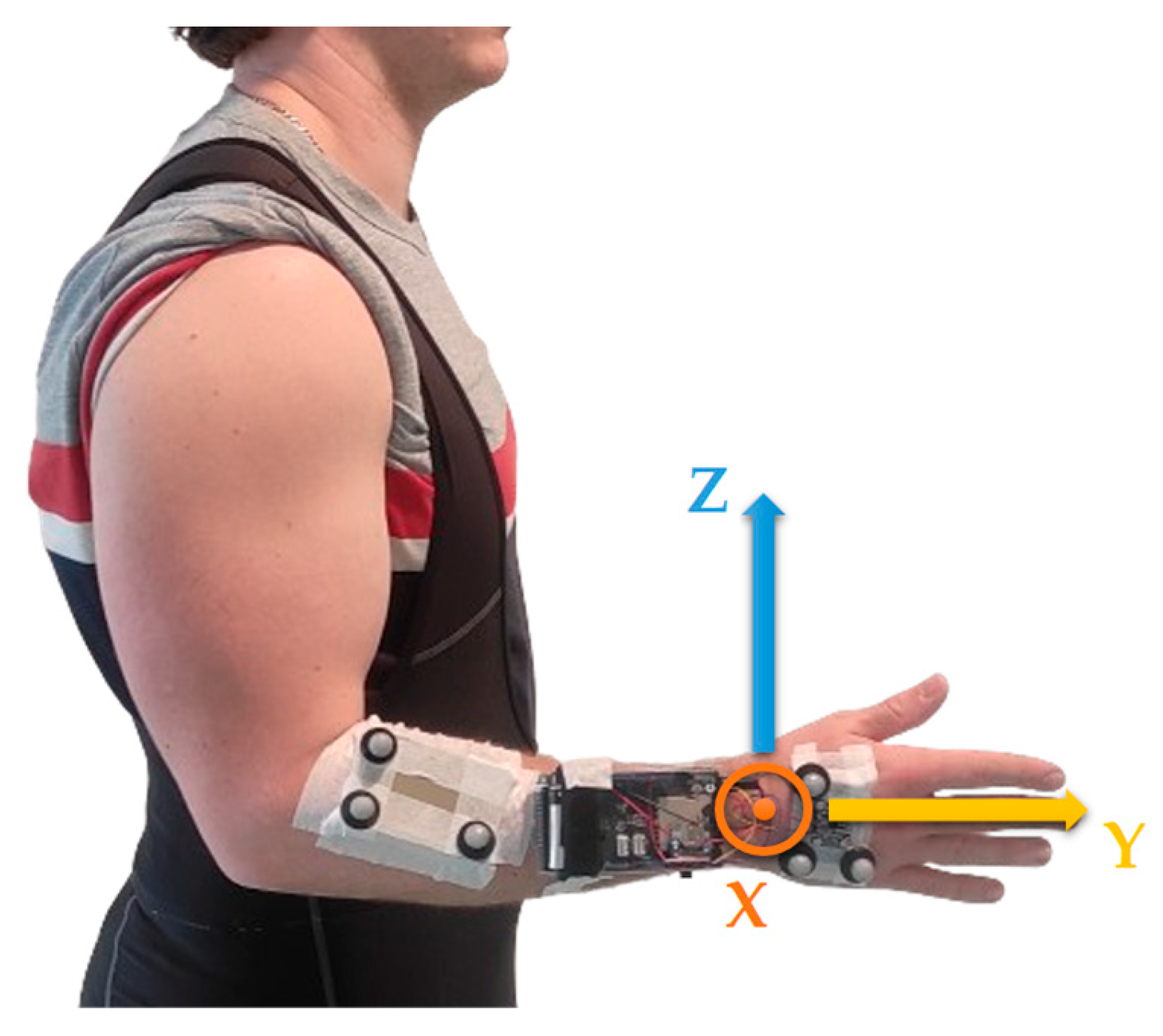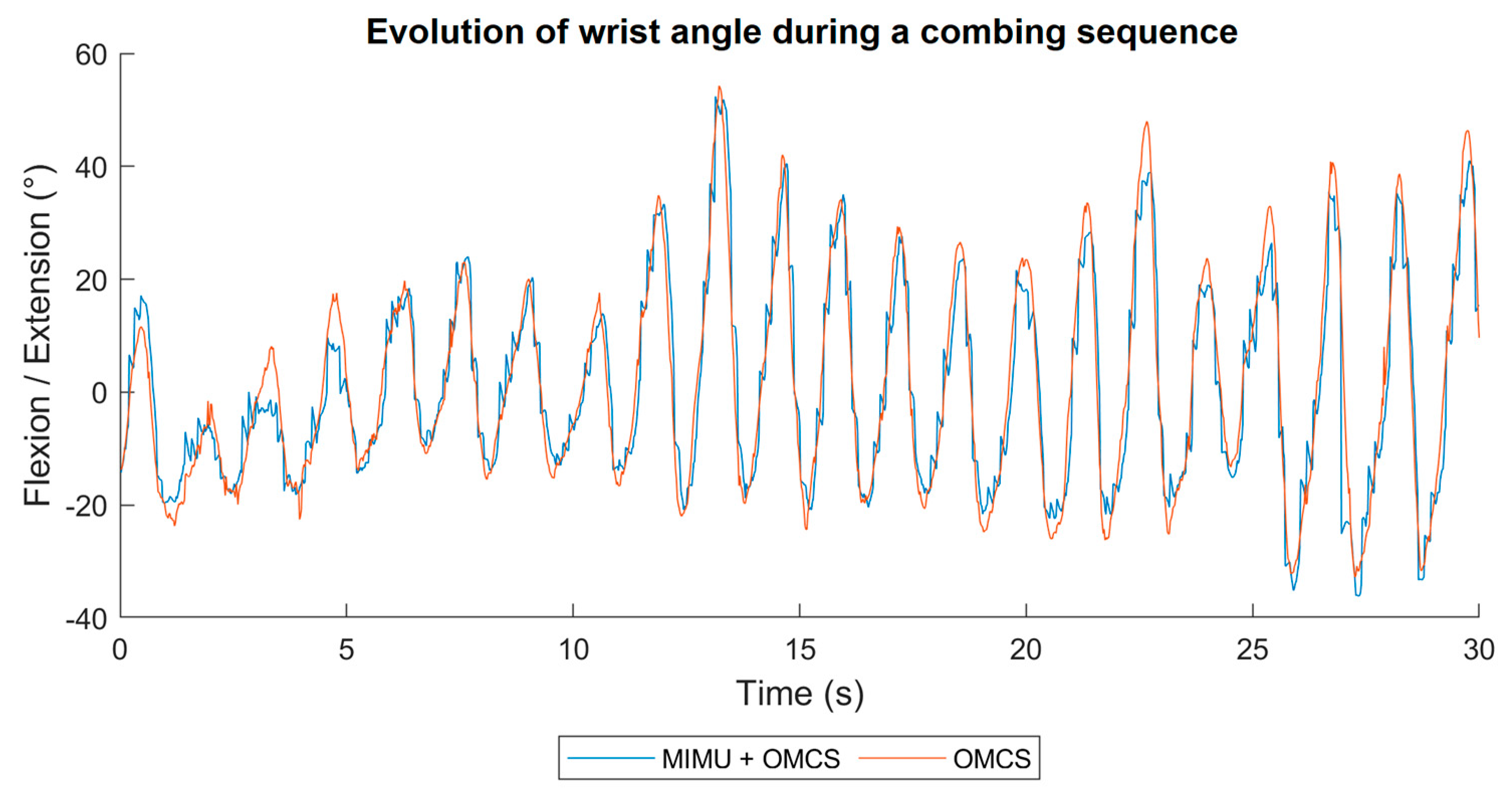Development and Evaluation of a Hybrid Measurement System to Determine the Kinematics of the Wrist
Abstract
1. Introduction
2. Materials and Methods
2.1. Device Description
2.2. Integration of MIMU into an OMCS
2.3. Determining Joint Angles
2.4. Experimental Setup
2.5. Statistical Analysis
3. Results
4. Discussion
5. Conclusions
Author Contributions
Funding
Informed Consent Statement
Data Availability Statement
Acknowledgments
Conflicts of Interest
Appendix A


References
- Weitbrecht, M.; Holzgreve, F.; Fraeulin, L.; Haenel, J.; Betz, W.; Erbe, C.; Maurer-Grubinger, C.; Wanke, E.M.; Brueggmann, D.; Nienhaus, A.; et al. Ergonomic Risk Assessment of Oral and Maxillofacial Surgeons—RULA Applied to Objective Kinematic Data. Hum. Factors 2022, 65, 187208211053073. [Google Scholar] [CrossRef]
- Kato, A.E.; Fathallah, F.A.; Miles, J.A.; Meyers, J.M.; Faucett, J.; Janowitz, I.; Garcia, E.G. Ergonomic Evaluation of Winegrape Trellis Systems Pruning Operation. J. Agric. Saf. Health 2006, 12, 17–28. [Google Scholar] [CrossRef] [PubMed]
- Wallius, M.-A.; Bragge, T.; Karjalainen, P.A.; Järvelin-Pasanen, S.; Rissanen, S.M.; Vartiainen, P.; Räsänen, K. Effects of Mop Handle Height on Forearm Muscle Activity, Wrist and Upper Arm Posture and Movement During Floor Mopping. IISE Trans. Occup. Ergon. Hum. Factors 2018, 6, 84–97. [Google Scholar] [CrossRef]
- Busuttil, N.A.; Reid, M.; Connolly, M.; Dascombe, B.J.; Middleton, K.J. A Kinematic Analysis of the Upper Limb during the Topspin Double-Handed Backhand Stroke in Tennis. Sports Biomech. 2022, 21, 1046–1064. [Google Scholar] [CrossRef] [PubMed]
- Carson, H.J.; Richards, J.; Mazuquin, B. Examining the Influence of Grip Type on Wrist and Club Head Kinematics during the Golf Swing: Benefits of a Local Co-Ordinate System. Eur. J. Sport Sci. 2019, 19, 327–335. [Google Scholar] [CrossRef]
- Okubo, H.; Hubbard, M. Kinematics of Arm Joint Motions in Basketball Shooting. Procedia Eng. 2015, 112, 443–448. [Google Scholar] [CrossRef]
- Turner, J.; Forrester, S.E.; Mears, A.C.; Roberts, J.R. The Influence of Tracking Marker Locations on Three-Dimensional Wrist Kinematics. J. Sci. Med. Sport. 2020, 23, 985–990. [Google Scholar] [CrossRef]
- Williams, B.K.; Sanders, R.H.; Ryu, J.H.; Graham-Smith, P.; Sinclair, P.J. Racket Orientation Angle Differences between Accurate and Inaccurate Squash Shots, as Determined by a Racket Embedded Magnetic-Inertial Measurement Unit. Sports Biomech. 2021, 1–13. [Google Scholar] [CrossRef] [PubMed]
- Mohr, M.; Peer, L.; De Michiel, A.; van Andel, S.; Federolf, P. Whole-Body Kinematic Adaptations to Running on an Unstable, Irregular, and Compliant Surface. Sports Biomech. 2023, 1–15. [Google Scholar] [CrossRef]
- El Fezazi, M.; Achmamad, A.; Jbari, A.; Jilbab, A. A Convenient Approach for Knee Kinematics Assessment Using Wearable Inertial Sensors during Home-Based Rehabilitation: Validation with an Optoelectronic System. Sci. Afr. 2023, 20, e01676. [Google Scholar] [CrossRef]
- Chan, Y.S.; Teo, Y.X.; Gouwanda, D.; Nurzaman, S.G.; Gopalai, A.A.; Thannirmalai, S. Musculoskeletal Modelling and Simulation of Oil Palm Fresh Fruit Bunch Harvesting. Sci. Rep. 2022, 12, 8010. [Google Scholar] [CrossRef] [PubMed]
- Bergamini, E.; Ligorio, G.; Summa, A.; Vannozzi, G.; Cappozzo, A.; Sabatini, A.M. Estimating Orientation Using Magnetic and Inertial Sensors and Different Sensor Fusion Approaches: Accuracy Assessment in Manual and Locomotion Tasks. Sensors 2014, 14, 18625–18649. [Google Scholar] [CrossRef] [PubMed]
- Poitras, I.; Bielmann, M.; Campeau-Lecours, A.; Mercier, C.; Bouyer, L.J.; Roy, J.-S. Validity of Wearable Sensors at the Shoulder Joint: Combining Wireless Electromyography Sensors and Inertial Measurement Units to Perform Physical Workplace Assessments. Sensors 2019, 19, 1885. [Google Scholar] [CrossRef]
- Mavor, M.P.; Ross, G.B.; Clouthier, A.L.; Karakolis, T.; Graham, R.B. Validation of an IMU Suit for Military-Based Tasks. Sensors 2020, 20, 4280. [Google Scholar] [CrossRef]
- Trojaniello, D.; Cereatti, A.; Pelosin, E.; Avanzino, L.; Mirelman, A.; Hausdorff, J.M.; Della Croce, U. Estimation of Step-by-Step Spatio-Temporal Parameters of Normal and Impaired Gait Using Shank-Mounted Magneto-Inertial Sensors: Application to Elderly, Hemiparetic, Parkinsonian and Choreic Gait. J. NeuroEngineering Rehabil. 2014, 11, 152. [Google Scholar] [CrossRef] [PubMed]
- Chen, H.; Schall, M.C.; Fethke, N. Effects of Movement Speed and Magnetic Disturbance on the Accuracy of Inertial Measurement Units. Proc. Hum. Factors Ergon. Soc. Annu. Meet 2017, 61, 1046–1050. [Google Scholar] [CrossRef]
- Aslani, N.; Noroozi, S.; Davenport, P.; Hartley, R.; Dupac, M.; Sewell, P. Development of a 3D Workspace Shoulder Assessment Tool Incorporating Electromyography and an Inertial Measurement Unit—A Preliminary Study. Med. Biol. Eng. Comput. 2018, 56, 1003–1011. [Google Scholar] [CrossRef]
- Tabrizi, S.S.; Pashazadeh, S.; Javani, V. Data Acquired by a Single Object Sensor for the Detection and Quality Evaluation of Table Tennis Forehand Strokes. Data Brief 2020, 33, 106504. [Google Scholar] [CrossRef]
- Punchihewa, N.G.; Miyazaki, S.; Chosa, E.; Yamako, G. Efficacy of Inertial Measurement Units in the Evaluation of Trunk and Hand Kinematics in Baseball Hitting. Sensors 2020, 20, 7331. [Google Scholar] [CrossRef]
- Roetenberg, D.; Veltink, P. Camera-Marker and Inertial Sensor Fusion for Improved Motion Tracking. Gait Posture 2005, 22 (Suppl. 1), 51–52. [Google Scholar]
- Marković, S.; Kos, A.; Vuković, V.; Dopsaj, M.; Koropanovski, N.; Umek, A. Use of IMU in Differential Analysis of the Reverse Punch Temporal Structure in Relation to the Achieved Maximal Hand Velocity. Sensors 2021, 21, 4148. [Google Scholar] [CrossRef] [PubMed]
- Topley, M.; Richards, J.G. A Comparison of Currently Available Optoelectronic Motion Capture Systems. J. Biomech. 2020, 106, 109820. [Google Scholar] [CrossRef] [PubMed]
- Huynh, D.Q. Metrics for 3D Rotations: Comparison and Analysis. J. Math. Imaging Vis. 2009, 35, 155–164. [Google Scholar] [CrossRef]
- Wu, G.; van der Helm, F.C.T.; (DirkJan) Veeger, H.E.J.; Makhsous, M.; Van Roy, P.; Anglin, C.; Nagels, J.; Karduna, A.R.; McQuade, K.; Wang, X.; et al. ISB Recommendation on Definitions of Joint Coordinate Systems of Various Joints for the Reporting of Human Joint Motion—Part II: Shoulder, Elbow, Wrist and Hand. J. Biomech. 2005, 38, 981–992. [Google Scholar] [CrossRef] [PubMed]
- Ong, Z.C.; Seet, Y.C.; Khoo, S.Y.; Noroozi, S. Development of an Economic Wireless Human Motion Analysis Device for Quantitative Assessment of Human Body Joint. Measurement 2018, 115, 306–315. [Google Scholar] [CrossRef]
- Raghavendra, P.; Sachin, M.; Srinivas, P.S.; Talasila, V. Design and Development of a Real-Time, Low-Cost IMU Based Human Motion Capture System. In Computing and Network Sustainability; Vishwakarma, H.R., Akashe, S., Eds.; Springer: Singapore, 2017; pp. 155–165. [Google Scholar]
- Cottam, D.S.; Campbell, A.C.; Davey, M.P.C.; Kent, P.; Elliott, B.C.; Alderson, J.A. Measurement of Uni-Planar and Sport Specific Trunk Motion Using Magneto-Inertial Measurement Units: The Concurrent Validity of Noraxon and Xsens Systems Relative to a Retro-Reflective System. Gait Posture 2022, 92, 129–134. [Google Scholar] [CrossRef]
- Sers, R.; Forrester, S.; Moss, E.; Ward, S.; Ma, J.; Zecca, M. Validity of the Perception Neuron Inertial Motion Capture System for Upper Body Motion Analysis. Measurement 2020, 149, 107024. [Google Scholar] [CrossRef]
- Robert-Lachaine, X.; Mecheri, H.; Muller, A.; Larue, C.; Plamondon, A. Validation of a Low-Cost Inertial Motion Capture System for Whole-Body Motion Analysis. J. Biomech. 2020, 99, 109520. [Google Scholar] [CrossRef]
- Chia, L.; Andersen, J.T.; McKay, M.J.; Sullivan, J.; Megalaa, T.; Pappas, E. Evaluating the Validity and Reliability of Inertial Measurement Units for Determining Knee and Trunk Kinematics during Athletic Landing and Cutting Movements. J. Electromyogr. Kinesiol. 2021, 60, 102589. [Google Scholar] [CrossRef]
- Robert-Lachaine, X.; Mecheri, H.; Larue, C.; Plamondon, A. Validation of Inertial Measurement Units with an Optoelectronic System for Whole-Body Motion Analysis. Med. Biol. Eng. Comput. 2017, 55, 609–619. [Google Scholar] [CrossRef]
- Caruso, M.; Sabatini, A.M.; Laidig, D.; Seel, T.; Knaflitz, M.; Della Croce, U.; Cereatti, A. Analysis of the Accuracy of Ten Algorithms for Orientation Estimation Using Inertial and Magnetic Sensing under Optimal Conditions: One Size Does Not Fit All. Sensors 2021, 21, 2543. [Google Scholar] [CrossRef] [PubMed]
- Valtonen Ornhag, M.; Persson, P.; Wadenback, M.; Astrom, K.; Heyden, A. Trust Your IMU: Consequences of Ignoring the IMU Drift. In Proceedings of the 2022 IEEE/CVF Conference on Computer Vision and Pattern Recognition Workshops (CVPRW), New Orleans, LA, USA, 19–20 June 2022; pp. 4467–4476. [Google Scholar]
- McAtamney, L.; Nigel Corlett, E. RULA: A Survey Method for the Investigation of Work-Related Upper Limb Disorders. Appl. Ergon. 1993, 24, 91–99. [Google Scholar] [CrossRef] [PubMed]
- Gilles, M.A.; Guélin, J.-C.; Desbrosses, K.; Wild, P. Motor Adaptation Capacity as a Function of Age in Carrying out a Repetitive Assembly Task at Imposed Work Paces. Appl. Ergon. 2017, 64, 47–55. [Google Scholar] [CrossRef] [PubMed]
- Gilles, M.A.; Wild, P. Grasping an Object at Floor-Level: Is Movement Strategy a Matter of Age? Appl. Ergon. 2018, 70, 34–43. [Google Scholar] [CrossRef] [PubMed]
- Martin, V.; Reimann, H.; Schöner, G. A Process Account of the Uncontrolled Manifold Structure of Joint Space Variance in Pointing Movements. Biol. Cybern. 2019, 113, 293–307. [Google Scholar] [CrossRef]
- Rein, R.; Bril, B.; Nonaka, T. Coordination Strategies Used in Stone Knapping. Am. J. Phys. Anthropol. 2013, 150, 539–550. [Google Scholar] [CrossRef]
- Claudon, L.; Desbrosses, K.; Gilles, M.A.; Pichené-Houard, A.; Remy, O.; Wild, P. Temporal Leeway: Can It Help to Reduce Biomechanical Load for Older Workers Performing Repetitive Light Assembly Tasks? Appl. Ergon. 2020, 86, 103081. [Google Scholar] [CrossRef]



| Step | Time |
|---|---|
| Reference position | 5 s |
| Maximum flexion | 5 s |
| Reference position | 5 s |
| Gesture (CUT or COMB) | 50 s |
| Reference position | 10 s |
| RMSE (Degrees) | CUT (N = 9) | COMB (N = 8) |
|---|---|---|
| Flexion/Extension | 4.5 ± 1.5 | 5.8 ± 0.9 |
| Abduction/Adduction | 5.1 ± 1.3 | 8.5 ± 1.4 |
| Pronation/Supination | 3.7 ± 1.2 | 8.5 ± 2.2 |
| Mean Speed (deg·s−1) | CUT (N = 9) | COMB (N = 8) |
|---|---|---|
| Flexion/Extension | 39.1 ± 9.0 | 52.2 ± 11.1 |
| Abduction/Adduction | 23.0 ± 5.0 | 56.7 ± 10.5 |
| Pronation/Supination | 31.3 ± 9.5 | 77.1 ± 15.2 |
Disclaimer/Publisher’s Note: The statements, opinions and data contained in all publications are solely those of the individual author(s) and contributor(s) and not of MDPI and/or the editor(s). MDPI and/or the editor(s) disclaim responsibility for any injury to people or property resulting from any ideas, methods, instructions or products referred to in the content. |
© 2024 by the authors. Licensee MDPI, Basel, Switzerland. This article is an open access article distributed under the terms and conditions of the Creative Commons Attribution (CC BY) license (https://creativecommons.org/licenses/by/4.0/).
Share and Cite
Dellai, J.; Gilles, M.A.; Remy, O.; Claudon, L.; Dietrich, G. Development and Evaluation of a Hybrid Measurement System to Determine the Kinematics of the Wrist. Sensors 2024, 24, 2543. https://doi.org/10.3390/s24082543
Dellai J, Gilles MA, Remy O, Claudon L, Dietrich G. Development and Evaluation of a Hybrid Measurement System to Determine the Kinematics of the Wrist. Sensors. 2024; 24(8):2543. https://doi.org/10.3390/s24082543
Chicago/Turabian StyleDellai, Jason, Martine A. Gilles, Olivier Remy, Laurent Claudon, and Gilles Dietrich. 2024. "Development and Evaluation of a Hybrid Measurement System to Determine the Kinematics of the Wrist" Sensors 24, no. 8: 2543. https://doi.org/10.3390/s24082543
APA StyleDellai, J., Gilles, M. A., Remy, O., Claudon, L., & Dietrich, G. (2024). Development and Evaluation of a Hybrid Measurement System to Determine the Kinematics of the Wrist. Sensors, 24(8), 2543. https://doi.org/10.3390/s24082543





